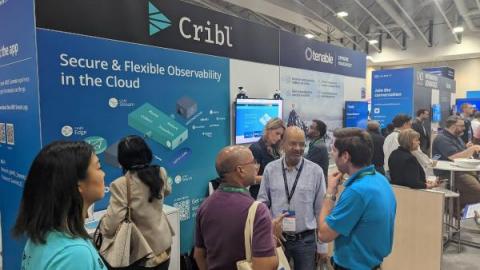Operations | Monitoring | ITSM | DevOps | Cloud
June 2023
Data Independence Day: Taking Back Control of Your Data!
On July 4th we celebrate. We celebrate freedom of movement, freedom of assembly, removal of excessive taxation, and much, much more. But what about digital independence? Removing the tyrannical yoke of control over your observability data. Authoritarian vendors restrict access and movement; they dictate proprietary formatting and even limit what can be commingled with your data, then apply enormous tax burdens (i.e. license fees) just to store your data.
The Goal With Every Release: Stay Laser Focused on Driving Value for Customers
As our customers share their frustrations with the volume and growth of their observability data, we’ve got our eyes set on making it easier to manage. Our Spring 4.1 Launch involved enhancements to the Cribl suite of products — Cribl Stream, Cribl Edge, and Cribl Search — that give users more choice and control over their end-to-end observability architecture.
Cribl Stream Simplifies Complexity in Multi Cloud Adoption
You may be thinking of investing in multiple cloud vendors to increase redundancy and deal with the complexity of your enterprise requirements. You are not alone. Many enterprises are moving in this direction to take advantage of the options offered by competing cloud vendors. Adopting one major cloud vendor is a complex project that can consume a company for months if not years.
Streamlining Data Management for Enterprise Security | SpyCloud
Customers First Always: Cribl's Support Team Shines in Gartner Peer Insights
Easy to implement, effective data management tools that provide fast time to value are the exception rather than the rule, and top-notch support for those tools is also hard to come by. That’s why Cribl prioritizes creating products that make the lives of engineers and systems admins as easy as possible. The reviews on Gartner Peer Insights give us a glimpse into how well we’re holding up our end of the bargain.
The Evils of Data Debt
In this livestream, Jackie McGuire and I discuss the harmful effects of data debt on observability and security teams. Data debt is a pervasive problem that increases costs and produces poor results across observability and security. Simply put — garbage in equals garbage out. We delve into what data debt is and some long term solutions. You can also subscribe to Cribl’s podcast to listen on the go!
Goats on the Road: 3 Key Takeaways From the 2023 AWS Summit in Washington, DC
The Cribl team just wrapped up the 2023 AWS Summit in Washington, DC, and we were thrilled to spend a few days chatting with public sector organizations looking to gain the freedom and flexibility our products offer.
The 2023 Observability Market Map - Key Trends, Players, and Directions
Cribl has a unique position right in the middle of the observability market, giving us a distinct view of all things security, APM, and log analysis. Observability as a concept has exploded into specialized areas over the past two years, and making sense of the players and market forces, particularly in a difficult macro environment, can be tricky. Let’s break it down.
Fundamentals of Searching Observability Data: Understanding the Search Process Can Save Time, Complexity, and Money!
On June 28th I will be hosting a webinar, ‘The Fundamentals of Searching Observability Data’. So why should you attend? Because things have, and will continue to change in the way we manage the IT data collected across the enterprise. A recent study shows that enterprises create over 64 zettabytes (ZB) of data, and that number is growing at a 27 percent compound annual growth rate (CAGR). The scary part?
Understanding Multi Cloud Observability
IT, DevOps, and security teams are figuring out the best ways to manage their complex, ever-growing, ever-changing environments. And one contributing factor to all the complexity is the rise of using multiple cloud services. One cloud service to manage is difficult enough, but adding more to the mix — each with its own interface and set of tools — makes everyone’s job significantly more difficult.
The First 100 Days With Cribl Stream: Start at the End to Progress Faster
A reference architecture is a lovely document, but they rarely help engineers and architects implement their tools effectively. Most reference architectures offer plenty of suggestions and ideas, but not enough context. We will explore ways to make reference architectures more useful while reducing reliance on the vague and dreaded “It Depends. Cribl has just released its first official reference architecture.
Setting Up a Data Loop using Cribl Search and Stream Part 2: Configuring Cribl Search
Setting Up a Data Loop using Cribl Search and Stream Part 1: Setting up the Data Lake Destination
Setting Up a Data Loop using Cribl Search and Stream Part 2: Configuring Cribl Search
Setting Up a Data Loop using Cribl Search and Stream Part 3: Send Data from Cribl Search to Stream
Setting Up a Data Loop using Cribl Search and Stream Part 4: Putting it All Together
Accelerate Investigations, Forensics and Audits Using Cribl Search and Amazon S3
In the era of big data, data lakes have emerged as a popular way to store and process massive amounts of data. Fortunately, with Cribl Search and Cribl Stream, you can create a Data Loop to optimize the use of your data lake by saving Search results as part of an investigation. Our four-part video series explains how to set up Cribl Search and Cribl Stream to establish a Data Loop using the Amazon S3 Data Lake destination in Cribl Stream and the Cribl Stream in_cribl_http source.
Modernize Your SIEM Architecture
Top 3 SIEM Optimizations - How to Get More From Your Existing Tech Stack
In today’s digital-first world, most security problems are actually data problems, and data volumes are outpacing organizations’ abilities to handle, process, and get value from it. You’ll have 250% more data in five years than you have today, but the chances of your budget increasing to match that are slim. The challenges that come with managing the rise in enterprise data volume directly affect your ability to adequately address cybersecurity risks.














